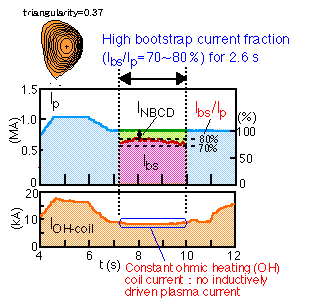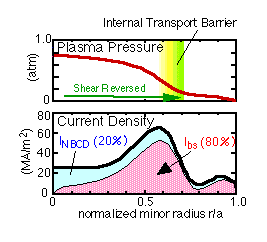Fully Non-Inductive Current Drive in Quasi-Steady Reversed Shear Plasma
In order to develop the method of non-inductive current drive for continuous generation of electric power in future tokamak fusion reactors, steady operation scenarios with a reversed shear plasma are being considered for ITER.
In JT-60U, a reversed shear plasma was sustained for 2.6 s in a quasi-steady state by fully non-inductive current drive, where the 70~80% of the plasma current Ip was driven by the bootstrap current Ibs and 20~30% by injected neutral beams INBCD as shown in Fig. 1. The sustained duration was enough for the proof of principle since it was sufficiently longer than the energy confinement time and was comparable to the characteristic relaxation time of the hollow current profile. In the plasma, a hollow current density profile was successfully formed by bootstrap current with a hollow region of ~60% wide of plasma minor radius as shown in Fig. 2. A high triangularity plasma cross section to increase the plasma stability and feedback control by neutral beams to maintain the stored energy constant were effectively utilized in the experiment. Simultaneously, the confinement improvement factor to the ELMy H-mode (HH factor) was doubled (HH  2). Consequently, both bootstrap current fraction Ibs/Ip and HH factor substantially exceed the requirements for the steady operation in ITER (for ITER, Ibs/Ip
2). Consequently, both bootstrap current fraction Ibs/Ip and HH factor substantially exceed the requirements for the steady operation in ITER (for ITER, Ibs/Ip  50%, HH=1).
50%, HH=1).
This result significantly contributes to the ITER physics R&D and provides the prospect for the steady state operation in a tokamak reactor. Experiments for further extension of sustainment and for higher plasma performance are planed.

Fig. 1 Reversed shear plasma was sustained for 2.6 s by fully non-inductive current drive.

Fig. 2 Hollow current density profile was formed by bootstrap current with a hollow region of ~60% wide of plasma minor radius (ACCOME calculation).
